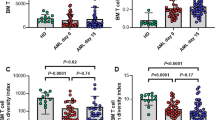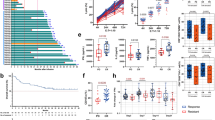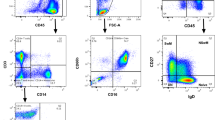Summary:
Relapse postautograft in acute myeloid leukaemia (AML), may in part arise from leukaemia cells present in the bone marrow (BM) inoculum, and the level of minimal residual disease (MRD) in BM harvests used for autografting may therefore be clinically important.We have used the WT1 transcript as a marker of MRD, which was quantitated by RQ-PCR, in the BM harvests of 24 patients receiving an ABMT for AML. ABL was used as a control gene with WT1 level being normalised to 105 copies of ABL per sample. Median WT1 level was 651 copies (range=113–32 700) for the 13 patients with relapse-free survival (RFS) of less than 5 years, and 174 (range=0–1900) for patients with RFS of over 5 years postautograft (P<0.04). The RFS was 10.5 months for patients with WT1 level of >2000 copies (n=5), and has not yet been reached for patients with WT1 level<2000 (n=21), at a median follow-up of 92 months (P<0.05). We show that elevated levels of MRD in BM harvests are associated with a higher relapse risk in patients autografted for AML.
This is a preview of subscription content, access via your institution
Access options
Subscribe to this journal
Receive 12 print issues and online access
$259.00 per year
only $21.58 per issue
Buy this article
- Purchase on Springer Link
- Instant access to full article PDF
Prices may be subject to local taxes which are calculated during checkout


Similar content being viewed by others
References
Burnett AK, Goldstone AH, Stevens RM et al. Randomised comparison of addition of autologous bone-marrow transplantation to intensive chemotherapy for acute myeloid leukaemia in first remission: results of MRC AML 10 trial. UK Medical Research Council Adult and Children's Leukaemia Working Parties. Lancet 1998; 351: 700–708.
Zittoun RA, Mandelli F, Willemze R et al. Autologous or allogeneic bone marrow transplantation compared with intensive chemotherapy in acute myelogenous leukemia. European Organization for Research and Treatment of Cancer (EORTC) and the Gruppo Italiano Malattie Ematologiche Maligne dell'Adulto (GIMEMA) Leukemia Cooperative Groups. N Engl J Med 1995; 332: 217–223.
Cassileth PA, Andersen JW, Bennett JM et al. Escalating the intensity of post-remission therapy improves the outcome in acute myeloid leukemia: the ECOG experience. The Eastern Cooperative Oncology Group. Leukemia 1992; 6 (Suppl 2): 116–119.
Brenner MK, Rill DR, Holladay MS et al. Gene-marking to trace origin of relapse after autologous bone-marrow transplantation. Lancet 1993; 341: 85–86.
Kreuzer KA, Saborowski A, Lupberger J et al. Fluorescent 5′-exonuclease assay for the absolute quantification of Wilms' tumour gene (WT1) mRNA: implications for monitoring human leukaemias. Br J Haematol 2001; 114: 313–318.
Cilloni D, Gottardi A, De Micheli D et al. Quantitative assessment of WT1 expression by real time quantitative PCR may be a useful tool for monitoring minimal residual disease in acute leukemia patients. Leukemia 2002; 16: 2115–2121.
Ogawa H, Tamaki H, Ikegame K et al. The usefulness of monitoring WT1 gene transcripts for the prediction and management of relapse following allogeneic stem cell transplantation in acute type leukemia. Blood 2003; 101: 1698–1704.
Garg M, Moore H, Tobal K, Liu Yin JA . Prognostic significance of quantitative analysis of WT1 gene transcripts by competitive reverse transcription polymerase chain reaction in acute leukaemia. Br J Haematol 2003; 123: 49–59.
Grimwade D, Walker H, Oliver F et al. The importance of diagnostic cytogenetics on outcome in AML: analysis of 1, 612 patients entered into the MRC AML 10 trial. The Medical Research Council Adult and Children's Leukaemia Working Parties. Blood 1998; 92: 2322–2333.
Chomczynski P, Sacchi N . Single-step method of RNA isolation by acid guanidinium thiocyanate–phenol–chloroform extraction. Anal Biochem 1987; 162: 156–159.
Grimwade D, Walker H, Oliver F et al. What happens subsequently in AML when cytogenetic abnormalities persist at bone marrow harvest? Results of the 10th UK MRC AML trial. Medical Research Council Leukaemia Working Parties. Bone Marrow Transplant 1997; 19: 1117–1123.
Reichle A, Rothe G, Krause S et al. Transplant characteristics: minimal residual disease and impaired megakaryocytic colony growth as sensitive parameters for predicting relapse in acute myeloid leukemia. Leukemia 1999; 13: 1227–1234.
Mizuta S, Ito Y, Kohno A et al. Accurate quantitation of residual tumor burden at bone marrow harvest predicts timing of subsequent relapse in patients with common ALL treated by autologous bone marrow transplantation. Nagoya BMT Group. Bone Marrow Transplant 1999; 24: 777–784.
Gorin NC, Labopin M, Meloni G et al. Autologous bone marrow transplantation for acute myeloblastic leukemia in Europe: further evidence of the role of marrow purging by mafosfamide. European Co-operative Group for Bone Marrow Transplantation (EBMT). Leukemia 1991; 5: 896–904.
Gorin NC, Aegerter P, Auvert B et al. Autologous bone marrow transplantation for acute myelocytic leukemia in first remission: a European survey of the role of marrow purging. Blood 1990; 75: 1606–1614.
Siehl JM, Thiel E, Leben R et al. Quantitative real-time RT-PCR detects elevated Wilms tumor gene (WT1) expression in autologous blood stem cell preparations (PBSCs) from acute myeloid leukemia (AML) patients indicating contamination with leukemic blasts. Bone Marrow Transplant 2002; 29: 379–381.
Acknowledgements
Dr David Osborne was a Leukaemia Research Fund Training Fellow.
Author information
Authors and Affiliations
Corresponding author
Rights and permissions
About this article
Cite this article
Osborne, D., Frost, L., Tobal, K. et al. Elevated levels of WT1 transcripts in bone marrow harvests are associated with a high relapse risk in patients autografted for acute myeloid leukaemia. Bone Marrow Transplant 36, 67–70 (2005). https://doi.org/10.1038/sj.bmt.1704992
Received:
Accepted:
Published:
Issue Date:
DOI: https://doi.org/10.1038/sj.bmt.1704992
Keywords
This article is cited by
-
Prognostic and therapeutic implications of minimal residual disease at the time of transplantation in acute leukemia
Bone Marrow Transplantation (2013)
-
Promising Role of Reduced-Toxicity Hematopoietic Stem Cell Transplantation (PART-I)
Stem Cell Reviews and Reports (2012)
-
Monitoring of WT1 expression in PB and CD34+ donor chimerism of BM predicts early relapse in AML and MDS patients after hematopoietic cell transplantation with reduced-intensity conditioning
Leukemia (2011)
-
Standardization of WT1 mRNA quantitation for minimal residual disease monitoring in childhood AML and implications of WT1 gene mutations: a European multicenter study
Leukemia (2009)



